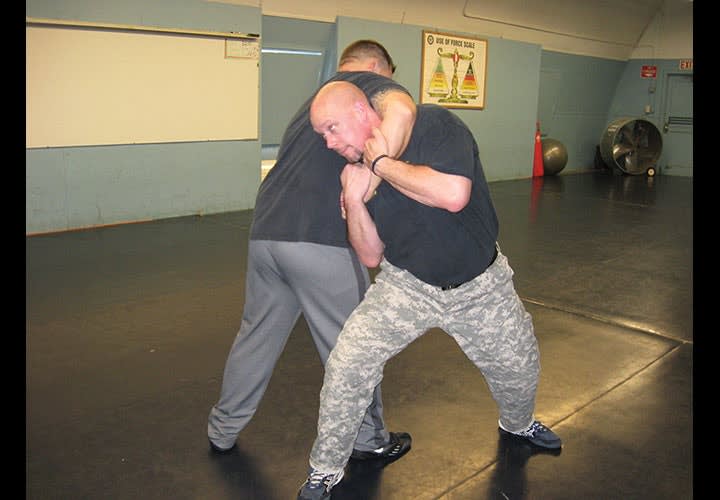You should immediately grab the assailant's wrist and inside the assailant's forearm and elbow area, pulling the choke away from your neck, while simultaneously turning your head toward the assailant's body. Both motions will help prevent a choke. After this immediate response, you can execute these two options for escape.
Opposite Side Takedown—Place your right hand over the assailant's back, grabbing onto the assailant's clothing, if possible. This will keep the assailant from lifting and driving you backward to complete the choke. If the assailant tries to lift you, the assailant will have to lift your entire body weight, keeping pressure off your neck. Now use your left hand to press against the assailant's upper leg or knee, keeping it in place and preventing knee strikes to your head. Keep a low base and move slightly back, pulling the assailant into a lower position. You can then work your way around to the opposite side of the choke, slightly behind the assailant. Working from a low, wide base with knees bent, place your left arm behind the assailant's legs, using it to drive toward the assailant's lower body, and lifting, while using your head and upper body to drive the assailant backward. This will result in taking the suspect to the ground and result in you being in a side-control position on the ground. From this position, you can bring your right forearm across the suspect's neck and apply pressure, forcing the assailant to release the choke.
Body Rotation Escape—A technique involving fewer steps, and perhaps less training, involves first grabbing the wrist and elbow of the assailant. Stepping beside the assailant with your right leg, continue with a quick, tight, clockwise rotation, making a complete turn toward the subject while lowering your body. The finishing move could end in an escape or a takedown, while you continue to maintain contact with the assailant's arm. It is important to create as much space as possible for your head to escape the choke. This technique is made more difficult if there is a large difference in size or strength.
Side Headlock Escapes
If an assailant grabs you from behind and initiates a headlock from the side, there are many options for escape. Grab the assailant's wrist and inside forearm, pulling the choke away from your neck while simultaneously turning your head toward the assailant's body. Both motions will help prevent a choke. After this immediate response, here are two options for escape.











